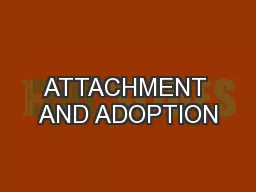

Presented By Elsebeth Green LCSW RPTS and Collette DawsonLoveless LCSW RPT Attachment The reciprocal dance between the caregiver and the child that develops over time and becomes a template for future relationships ID: 529135
Download Presentation The PPT/PDF document "ATTACHMENT AND ADOPTION" is the property of its rightful owner. Permission is granted to download and print the materials on this web site for personal, non-commercial use only, and to display it on your personal computer provided you do not modify the materials and that you retain all copyright notices contained in the materials. By downloading content from our website, you accept the terms of this agreement.
Slide1
ATTACHMENT AND ADOPTION
Presented By
Elsebeth Green, LCSW, RPT-S
and
Collette Dawson-Loveless, LCSW, RPTSlide2
AttachmentThe reciprocal dance between the caregiver and the child that develops over time and becomes a template for future relationships.Slide3
Arousal/Relaxation CycleDr. Vera Fahlberg, Separation and Attachment, 1979
Need
s
Arousal
Need Met (By caregiver)
Relaxation
safety
Secure Attachment
&Trust
belonging
esteem
PROXIMITYSlide4Slide5
Regulation of Nervous System
Brain = Central Nervous System
and
entire body
Particularly the nerve bundles surrounding the heart and gut
Optimal brain
activity = optimal
bodily
arousal
Healthy, Calm Brain = Healthy Physiological FunctioningSlide6
The Neurobiology of AttachmentAttachment dynamics impact the following areas of brain development:Neurochemical activitySize/development of brain tissue
Emotional RegulationRegulation of the nervous systemConcepts about self/others/the world
MemorySlide7
Positive Effects of Secure AttachmentThe development of
languageAbility to assume the view point of another
The
development of trust
and
positive
world view
The development of self-
esteem
Anxiety reduction and sense
of securityLove of physical touch and intimacyLearning through social interactionsAbility to play and share mutual enjoyment
Healthy, brief shame as vehicle for socializationSelf-reliance and reliance on othersOrganized meaningful emotion
IntersubjectivitySlide8 Primary
IntersubjectivityThe infant and parents’ exploration of and discovery of each other and self in relation to the other is two-fold: 1. Eyes, voice, gestures and touch of father and mother to the infant (I’m special, interesting, lovable to my parent)
2. Eyes, voice, gestures and touch of infant to parent (I’m a good parent)
Trevarthen
, 2001,
Trevarthen
& Aiken 2001 Slide9
Secondary Intersubjectivity An infant’s discovery of the features of the world (people, objects and events) through the impact of the world on themselves and their parents: 1. meaning
2. template for relating to others and the world 3. person-to-person-to-object relationships are established
Slide10MindsightSlide11
When things go wrongSlide12ATTACHMENT CYCLE - Anxious
- - A
DISTRUSTSlide13ATTACHMENT CYCLE- Avoidant
DISTRUSTSlide14ATTACHMENT CYCLE - Disorganized
DISTRUSTSlide15
STYLES OF ATTACHMENTSECURE
–
SENSE OF SAFETY, BELONGING AND ESTEEM 55%
ANXIOUS
-
FEAR OF REJECTION 15%
AVOIDANT
–
FEAR OF BEING TRAPPED 20%DISORGANIZED – DEEPLY WOUNDED WITH NO DISCERNABLE PATTERN OF RELATING 5%Slide16
DSMV Diagnosis we commonly use:309.81 -Post-traumatic Stress Disorder –recurrent, involuntary, and intrusive distressing memories of exposure to actual or threatened death, serious injury, or sexual violence. Intense or prolonged psychological distress at exposure to internal or external cues that symbolize or resemble an aspect of the traumatic event.
995.54 Child Abuse – Confirmed995.53 Child Sexual Abuse - Confirmed
995.52 Child Neglect – Confirmed
995.51 Child Psychological Abuse, Confirmed
V61.20 Parent-child relational problem
313.89 Reactive Attachment Disorder
-Consistent pattern of withdrawn behavior, not seeking, not accepting comfort; minimal social engagement
313.89
Disinhibited Social Engagement Disorder - overly familiar verbal and physical behavior with unfamiliar adult with diminished or absent checking back with main caregiverSlide17
Traits of Severely Attachment Disordered Children
Angry and controlling
Mean and hurtful
Affectionate/charming when it suits them
Lie and steal
Create conflict between others to divide them
See others as objects to be manipulated
“Play” with behavior plans to get what they want
People seem to mean nothing to them except as vehicles to get needs met; servants; do not miss them or feel “love”Hurt animals and younger childrenPut up huge resistance to limit setting or consequencesSelf soothe in various inappropriate waysSlide18Discovering your own style . . .
What is your own attachment stylePASTBackgroundRelationshipsSeparationDiscipline
Fear/ThreatLoss
Emotional Communication
Safe Harbor (Secure Base)
Launching Pad (Safe Haven)
PRESENT
FUTURESlide19
ESTABLISHING PACE Daniel HughesPlayfulnessA
cceptanceCuriosityE
mpathySlide20
Principals of TreatmentEye contact, voice tone, touch, movement and gestures are only to communicate safety, acceptance, curiosity, playfulness and empathy and are only reciprocal – never coerced.Opportunities for enjoyment and laughter, play and fun, are provided daily and unconditionally.
Decisions are made for the purpose of providing success not failures.Successes become the basis for the development of age-appropriate skills.Slide21
The child’s symptoms or problems are accepted and contained. The child is shown how these simply reflect his history. They are often associated with shame which must be reduced by the adult’s response to the behavior.The child’s resistance to parenting and treatment interventions is responded to with acceptance, curiosity and empathy.Skills are developed in a patient manner, accepting and celebrating “baby-steps” as well as developmental plateaus.
The adult’s emotional self-regulation abilities must serve as a model for the child.The child needs to be able to make sense of his/her history and current functioning. The understood reasons are not excuses, but rather they are realities necessary to understand the developing self and current
struggles.
The adults must constantly strive to have empathy for the child and to never forget that, given his/her history, s/he is doing the best s/he can.Slide22
11. The child’s avoidance and controlling behaviors are survival skills developed under conditions of overwhelming trauma. They will decrease as a sense of safety increases, and while they may need to be addressed, this is not done with anger, withdrawal of love, or shame.Slide23Experience with States
Feel Better with Just one Word YouTubeSlide24Resource List
Building the Bonds of Attachment, Daniel HughesBrainstorm: The Power and Purpose of the Teenage Brain, Daniel J. SiegelThe Whole-Brain Child, Daniel J. SiegelLove Sense: The Revolutionary New Science of Romantic Relationships, Sue JohnsonBrain-Based Parenting, Daniel Hughes and Jonathan BaylinParenting the Hurt Child, Keck and
KupeckyThe Neurobiology of We, Daniel J. SiegelMindsight, Daniel J. SiegelRemoved
,
http
://vimeo.com/
73172036
Feel
Better with Just One Word, https://www.youtube.com/watch?v=0E82oV_BeLo